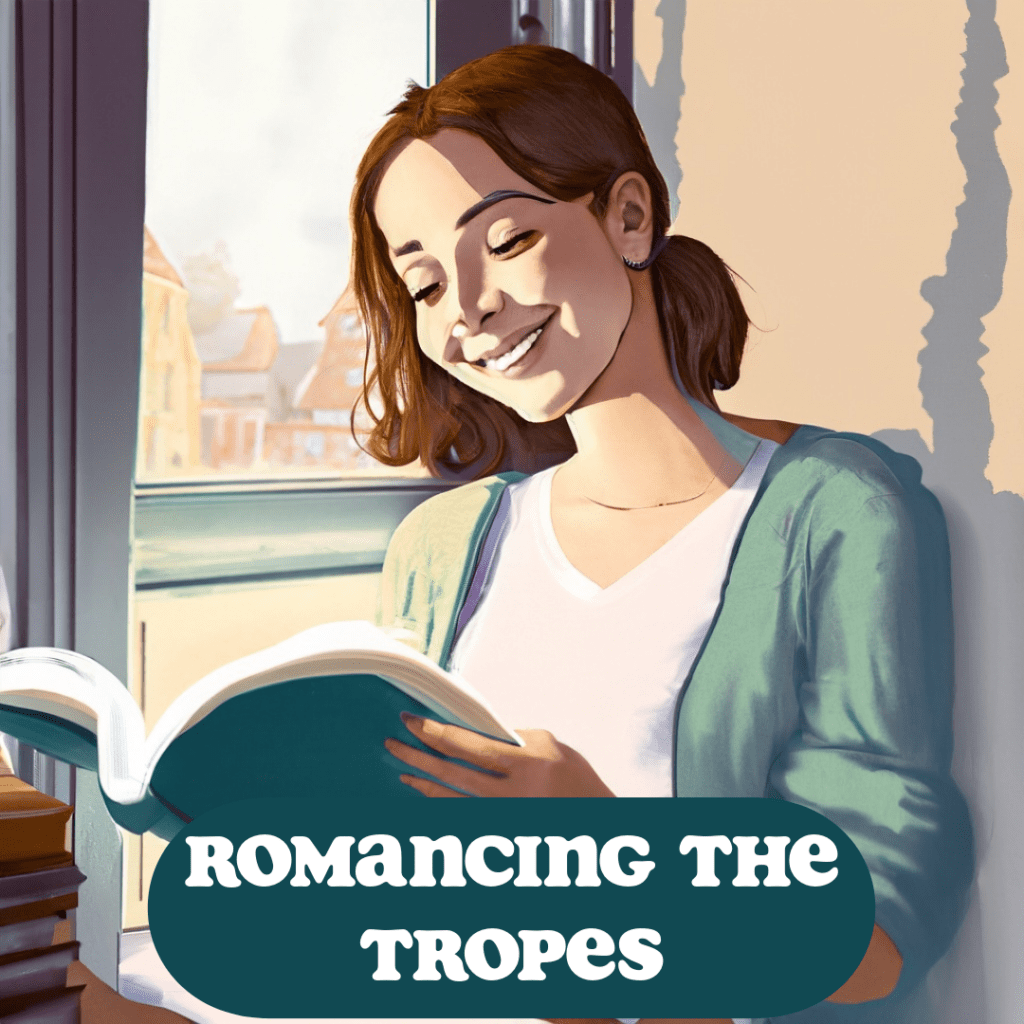Romancing the Tropes

by JT
Exploring the popular tropes and archetypes that shape romance novels, from enemies-to-lovers to second-chance romance.
Romance novels have captured the hearts of readers for centuries, weaving tales of passion, longing, and everlasting love. They’ve certainly captured our hearts here at TRS. At the core of these captivating narratives lie romance tropes and archetypes—recurring themes and character types that add depth and familiarity to the stories we adore.
What do we mean by “romance tropes?” Tropes are recurring narrative devices or themes found in literature, films, and other forms of storytelling. In the romance genre, these tropes manifest as common relationships. From enemies to lovers and second-chance romance to friends to lovers and the alpha hero, these tropes create a framework that authors use to craft their tales of love.
Why are romance novels so beloved? The enduring popularity of the genre lies in its ability to transport readers to worlds filled with passion and emotions. Romance novels provide a much-needed escape from reality, offering moments of respite and a chance to experience the exhilaration of falling in love. They evoke a range of emotions—heartache, joy, and everything in between—which resonates deeply with readers.
Our purpose here is to delve into the impact and appeal of romance tropes. By understanding the underlying mechanics of these tropes, we can appreciate how they create tension, emotional growth, and transformation within the story.
Enemies-to-Lovers: Igniting Love from the Flames of Hatred
When you’re talking about romance tropes, the enemies-to-lovers trope reigns supreme, captivating readers with its intoxicating blend of conflict, passion, and eventual bliss. This trope revolves around characters who start off as adversaries, fueled by animosity and disdain, only to discover a love that transcends their initial differences.
The enemies-to-lovers trope is characterized by intense emotional tension and sharp verbal sparring. It keeps readers on the edge of their seats, eagerly awaiting the moment when the animosity transforms into something more profound. One prime example of this trope can be found in Jane Austen’s timeless classic, “Pride and Prejudice,” where the initial disdain between Elizabeth Bennet and Mr. Darcy gives way to a profound and enduring love.
This trope’s appeal lies in the journey of emotional growth and transformation. As the characters navigate their shared obstacles, their initial hatred morphs into a profound understanding and empathy. Witnessing this metamorphosis is both satisfying and inspiring, as it reminds us of the boundless capacity for change and personal growth within ourselves and others.
It’s important to acknowledge the criticisms and challenges associated with the enemies-to-lovers trope. Some argue that it romanticizes toxic behavior, as characters may exhibit manipulative or hurtful actions during the enemies phase. It’s crucial for authors to handle this trope with care, ensuring that the transformation stems from genuine emotional development rather than mere convenience.
The enemies-to-lovers trope invites us to explore the intricate dynamics of love born from conflict. It challenges us to reflect on the transformative power of understanding, forgiveness, and the redemptive nature of true love.
Second-Chance Romance: Rediscovering Love’s Embrace
Second-chance romance, a cherished trope in the genre, encapsulates the hope and magic of love rekindled. It revolves around individuals who find themselves given a second opportunity at love with a past flame, reigniting the flames of a once-lost or unfulfilled connection.
At its core, second-chance romance is characterized by elements such as shared history, unresolved emotions, and a renewed sense of possibility. Notable examples from literature and media include Nicholas Sparks’ “The Notebook” and the film “La La Land,” where characters are given a chance to revisit a love that once slipped through their fingers.
The emotional depth and complexity of second-chance romance lie in the exploration of themes such as forgiveness, personal growth, and redemption. It delves into the transformative power of love and how it can heal wounds from the past, allowing characters to confront their regrets, learn from their mistakes, and evolve as individuals.
Forgiveness plays a significant role in second-chance romance, as characters must grapple with past hurts and find the strength to let go of resentment. This journey of forgiveness enables personal growth and creates an opportunity for redemption, both for the characters and the relationship itself.
As we delve into the world of second-chance romance, we embark on a poignant exploration of love’s resilience. It invites us to reflect on the complexities of human connections and the profound capacity for change and growth within each of us.
Friends-to-Lovers: Navigating the Path from Companionship to Passion
Among the treasured romance tropes, the friends-to-lovers storyline holds a special place in our hearts. This trope beautifully captures the delicate evolution of a bond, as two individuals transition from close friends to romantic partners, discovering a love that was simmering beneath the surface all along.
Defining the friends-to-lovers trope is recognizing the unique dynamics of friendship as the foundation for a romantic relationship. Notable instances of this trope can be found in popular romance novels and films, such as “When Harry Met Sally” and the novel “The Rosie Project,” where deep connections forged through companionship bloom into passionate love.
Central to the friends-to-lovers trope is the emotional connection that builds over time. These characters know each other intimately, sharing secrets, dreams, and countless laughter-filled moments. This familiarity and trust are a strong bedrock for love to flourish, creating a sense of security and comfort in the relationship.
Transitioning from friends to lovers requires navigating the path of risk and vulnerability. The fear of losing a cherished friendship can often deter individuals from taking that leap of faith. Embracing vulnerability, however, allows for the possibility of a deeper connection and a love that transcends the boundaries of friendship.
As we explore this trope, we celebrate the beauty of companionship that blossoms into a profound love story. It reminds us that the strongest relationships are often rooted in a deep understanding and shared experiences.
The Alpha Hero: Strong, Seductive, and Problematic
Romance novels have long been dominated by a captivating archetype: the alpha hero. These larger-than-life characters embody strength, confidence, and magnetism, captivating readers’ hearts and minds. The allure of the alpha hero lies in their ability to sweep the protagonist off her feet, offering protection, passion, and a sense of adventure.
The alpha hero possesses a distinct set of traits that make them instantly recognizable. They are often physically powerful, with chiseled features and an aura of undeniable charisma. Confidence radiates from them effortlessly, drawing others towards their commanding presence. They’re fiercely protective, willing to go to great lengths to safeguard their loved ones. Despite their sometimes gruff exterior, alpha heroes are known to possess a tender heart beneath the surface.
The allure of the alpha hero stems from the escapism they provide. They embody fantasies of adventure, passion, and undying devotion. The alpha hero archetype has also faced criticism for perpetuating toxic masculinity and reinforcing gender stereotypes. Critics argue that the alpha hero’s dominant and possessive tendencies can be problematic, portraying unhealthy relationship dynamics.
In response to these concerns, modern romance authors have begun to subvert and redefine the alpha hero archetype. These alternative portrayals emphasize consent, communication, and emotional vulnerability. Authors are crafting heroes who balance strength with empathy, creating characters who respect their partners as equals. By challenging traditional gender roles and embracing multifaceted masculinity, these authors offer readers a more inclusive and empowering vision of love.
Unlocking the Magic of Romance Tropes
Throughout this exploration of romance tropes and archetypes, we have uncovered the captivating essence of love stories. From enemies-to-lovers, where love triumphs over animosity, to second-chance romance, which offers a chance to rekindle lost love, and friends-to-lovers, where companionship blossoms into passion, these tropes have shaped our understanding of love and relationships.
The enduring impact and evolution of romance tropes can’t be overstated. These narrative devices have stood the test of time, captivating readers across generations. They tap into universal desires and emotions, resonating deeply within our hearts. As we continue to delve into the world of romance literature and media, new tropes emerge, reflecting the changing dynamics of society and offering fresh perspectives on love.
Diverse representation and fresh approaches are vital in romance literature. By embracing a range of characters, relationships, and experiences, we foster inclusivity and empower readers to see themselves reflected in these narratives. The importance of diverse representation extends beyond mere tokenism; it allows for authentic storytelling that celebrates the richness of human connections and fosters a deeper understanding of love in all its forms.
Romance tropes hold immense significance in shaping our understanding of love and relationships. They invite us to explore the complexities of human emotions, the transformative power of forgiveness and personal growth, and the delicate dance between friendship and passion. By engaging with these tropes, we embark on a journey of self-reflection and connection, discovering truths about ourselves and the world around us.
Romance tropes are not mere storytelling devices; they are the threads that weave together the fabric of our understanding and experience of love.
